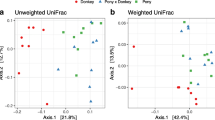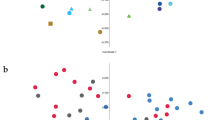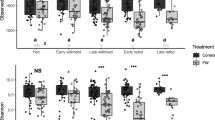Abstract
Fecal bacteria and protozoa of Hokkaido native horses and light horses were enumerated to compare seasonal variation in hindgut microbes and fermentation between the two breeds. Fecal samples were collected in winter and summer from eight horses (four for each breed) that had been reared together under the same conditions after birth (on woodland pasture in winter and on grassland pasture for the rest of the year). Total fecal bacteria counts for both breeds showed temporal variation, with the highest levels occurring in summer (P<0.05). For both breeds, Gram-negative rods were the major constituents (58–69%) and showed higher counts in winter (P<0.05) than in summer. Total protozoa counts in both breeds were lower in winter than in summer (P<0.05). The proportion of large cellulolytic protozoa such as Cochliatoxum periachtum was increased (P<0.05) in winter, and this tended to be more pronounced in native horses. Although total volatile fatty acids (VFA) in feces were lower in winter (P<0.05), the reduction was smaller in native horses (P<0.05). Fecal VFA pattern showed a shift toward more acetate and less propionate production in winter regardless of the horse breed. Evaluation of digestive tract organs in 12 animals showed that the relative weight of the colon in body weight or total digestive tract weight is larger in native horses than in light horses (P<0.05). The present results suggest that hindgut microbial adaptation to winter diets occurs to a greater extent in native horses, as partly characterized by advantages in anatomy.

Similar content being viewed by others
References
Cunha TJ (1991) The digestive tract. In: Cunha TJ (ed) Horse feeding and nutrition. Academic Press, San Diego, Calif., pp 28–38
Dehority BA, Demarais S, Osborn DA (1999) Rumen ciliates of white-tailed deer, axis deer, sika deer, fallow deer from Texas. J Eukaryot Microbiol 46:125–131
Drogoul C, Poncet C, Tisserand JL (2000a) Feeding ground and pelleted hay rather than chopped hay to ponies. 1. Consequences for in vivo digestibility and rate of passage of digesta. Anim Feed Sci Technol 87:117–130
Drogoul C, Poncet C, Tisserand JL (2000b) Feeding ground and pelleted hay rather than chopped hay to ponies. 2. Consequences on fiber degradation in the cecum and the colon. Anim Feed Sci Technol 87:131–145
Gill M, Oldham JD (1993) Growth. In: Forbes JM, France J (eds) Quantitative aspects of ruminant digestion and metabolism. CAB International, Wallingford, pp 383–403
Goodson J, Tyznik EJ, Cline JH, Dehority BA (1988) Effect of an abrupt diet change from hay to concentrate on microbial numbers and physical environment in the cecum of the pony. Appl Environ Microbiol 54:1946–1950
Hintz HF, Hogue DE, Walker Jr EF, Lowe JE, Schryver HF (1971) Apparent digestion in various segments of the digestive tract of ponies fed diets with varying roughage-grain ratios. J Anim Sci 32:245–248
Hobson PN, Mann SO, Summers R (1975) Rumen micro-organisms in red deer, hill sheep and reindeer in the Scottish highlands. Proc R Soc Edin B 75:171–180
Ichimura Y, Yamano H, Takano T, Koike S, Kobayashi Y, Tanaka K, Ozaki N, Suzuki M, Okada H, Yamanaka M (2004) Rumen microbes and fermentation of wild sika deer on the Shiretoko peninsula of Hokkaido island, Japan. Ecol Res 19:389–395
Ike K, Imai S, Ishii T (1985) Establishment of intestinal ciliates in new-born horses. Jpn J Vet Sci 47:39–43
Julliand V, DeVaux A, Millet L, Fonty G (1999) Identification of Ruminococcus flavefaciens as the predominant cellulolytic bacterial species of the equine cecum. Appl Environ Microbiol 65:3738–3741
Kawai M, Shingu Y, Inaba H, Kondo S, Hata H, Okubo M (1998) Comparison in intake and digestibility of Sasa nipponica between Hokkaido native horses and light horses grazed on woodland pasture. In: Proceedings of 10th Japanese Society of Equine Science, p 24
Kern DL, Slyter LL, Weaver JM, Leffel EC, Samuelson G (1973) Pony cecum vs steer rumen: the effect of oats and hay on the microbial ecosystem. J Anim Sci 37:463–469
Kern DL, Slyter LL, Leffel EC, Weaver JM, Oltjen RR (1974) Ponies vs steers: micobial and chemical characteristics of intestinal ingesta. J Anim Sci 38:559–564
Koike S, Shingu Y, Inaba H, Kawai M, Kobayashi Y, Hata H, Tanaka K, Okubo M (2000) Fecal bacteria in Hokkaido native horses as characterized by microscopic enumeration and competitive polymerase chain reaction assays. J Equine Sci 11:45–50
Kondo S (2001) Zoology of horses. University of Tokyo Press, Tokyo
Lin C, Stahl DA (1995) Taxon-specific probes for the cellulolytic genus Fibrobacter reveal abundant and novel equine-associated populations. Appl Environ Microbiol 61:1348–1351
Mackie RI, Wilkins CA (1988) Enumeration of anaerobic bacterial microflora of the equine gastrointestinal tract. Appl Environ Microbiol 54:2155–2160
Moore BE, Dehority BA (1993) Effects of diet and hindgut defaunation on diet digestibility and microbial concentrations in the cecum and colon of the horse. J Anim Sci 71:3350–3358
Ogimoto K, Imai S (1981) In: Atlas of rumen microbiology. Japan Scientific Societies Press, Tokyo
Orpin CG, Mathisen SD, Greenwood Y, Blix AS (1985) Seasonal changes in the ruminal microflora of the high-arctic Svalbard reindeer (Rangifer tarandus platyrhynchus). Appl Environ Microbiol 50:144–151
Shingu Y, Kawai M, Inaba H, Kondo S, Hata H, Okubo M (2000) Voluntary intake and behavior of Hokkaido native horses and light half-bred horses in woodland pasture. J Equine Sci 11:69–73
Stewart CS (1996) Microorganisms in hindgut fermentors. In: Mackie RI, White BA, Issacson RE (eds) Gastrointestinal microbiology, vol. 2. Chapman & Hall, New York, pp 162–171
Suto T (1973) Examination of the rumen. In: Nakamura R, Yonemura H, Suto T (eds) The clinical investigation of the bovine. Nosangyoson Bunka Kyokai, Tokyo, pp 11–14
Van Soest PJ (1994) Microbes in the gut. In: Van Soest PJ (ed) Nutritional ecology of the ruminant. Cornell University Press, Ithaca, N.Y., pp 253–280
Acknowledgement
This study was supported in part by a Grant-in-Aid for Scientific Research (no. 12460116) from the Ministry of Education, Science, Culture, Sports and Technology of Japan.
Author information
Authors and Affiliations
Corresponding author
About this article
Cite this article
Kobayashi, Y., Koike, S., Miyaji, M. et al. Hindgut microbes, fermentation and their seasonal variations in Hokkaido native horses compared to light horses. Ecol Res 21, 285–291 (2006). https://doi.org/10.1007/s11284-005-0118-x
Received:
Accepted:
Published:
Issue Date:
DOI: https://doi.org/10.1007/s11284-005-0118-x




